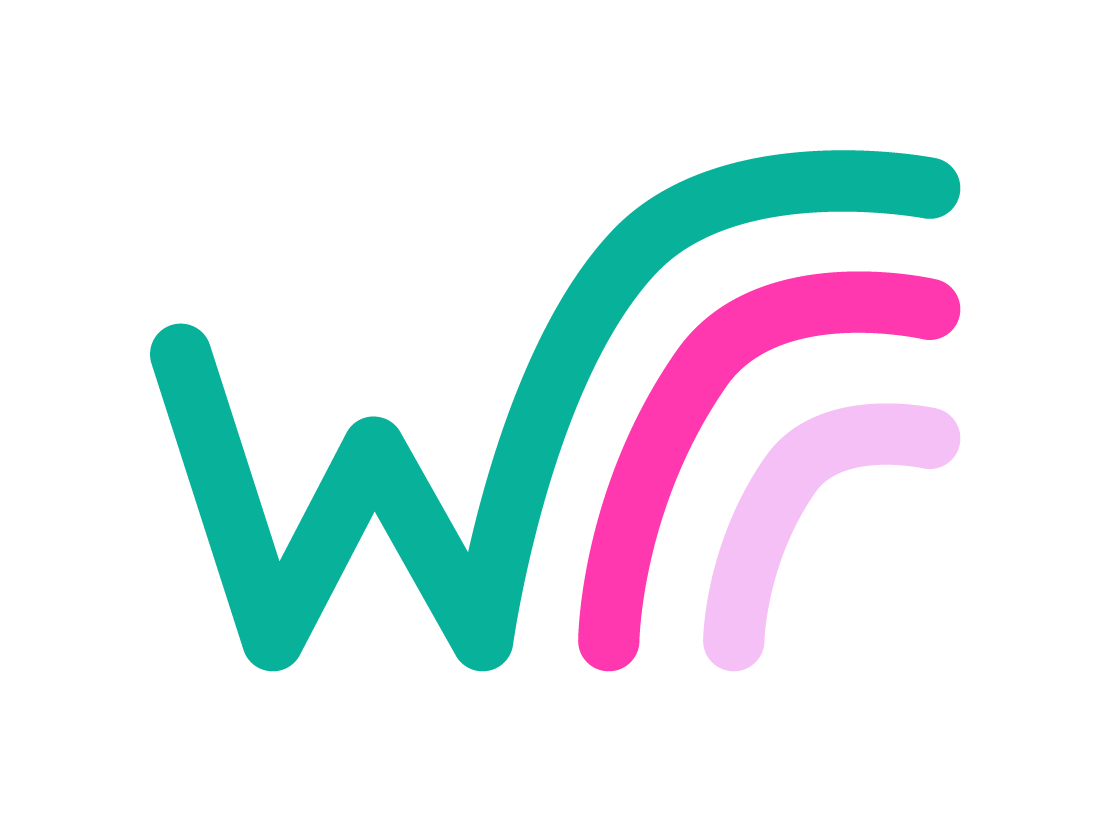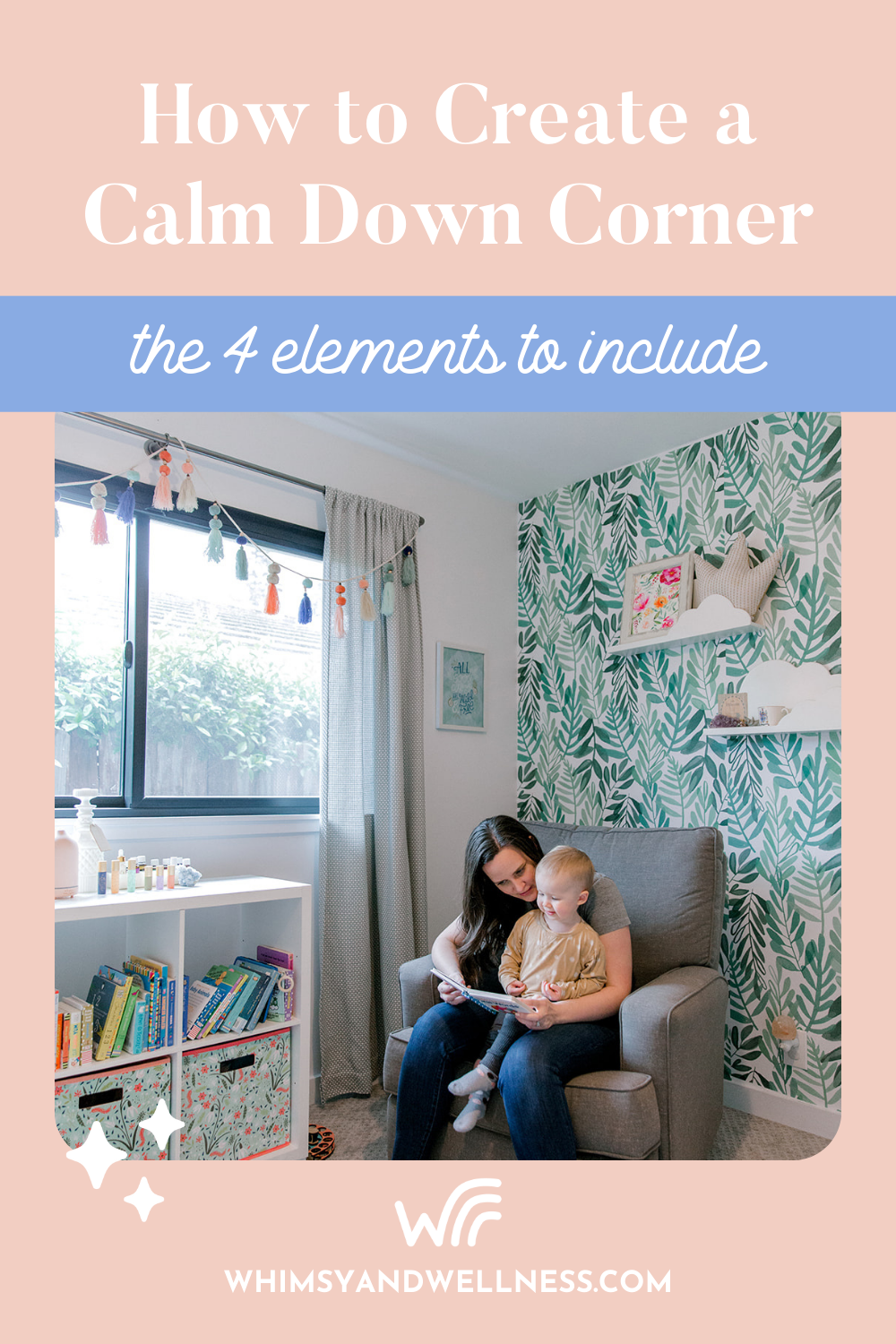
Calm down corners (also called peace corners or sensory corners) are areas in your house or classroom for children or grown ups (here’s a great example of what they can look like!).
Teachers, parents, and caregivers LOVE calm down corners because they help reduce emotional meltdowns and unhealthy behaviors at home or in the classroom.
They do this by helping children learn to self-regulate, develop emotional intelligence, grow relational skills, and move out of fear-or-flight so that they can use their logical brains again.
Calm down corners can be used at school or at home. They’re incredibly helpful tools for:
- Toddlers as young as 18 months
- Preschoolers
- Elementary kids
- Adults
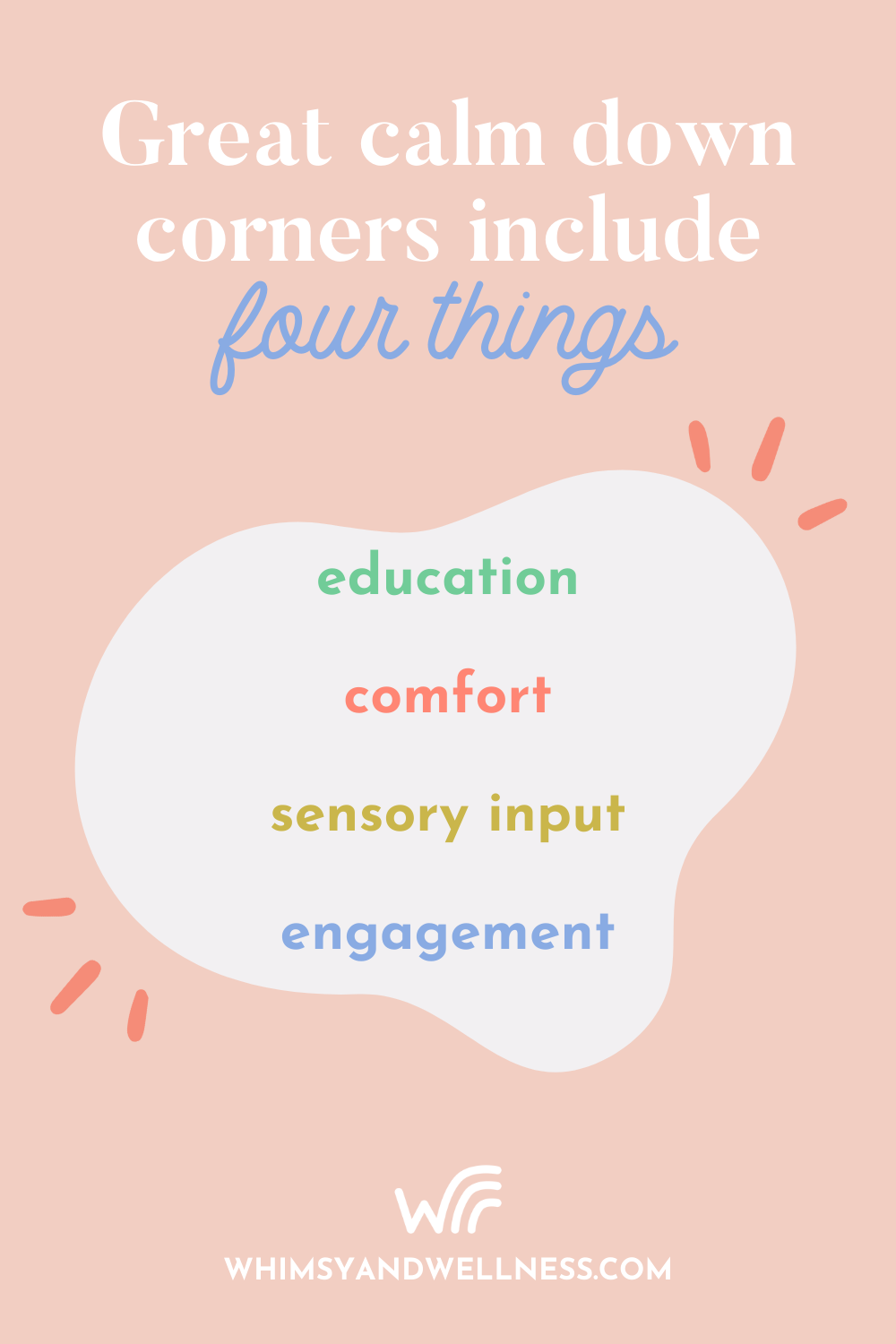
Great calm down corners include four elements: education, comfort, sensory input, and engagement.
Keep reading for how to incorporate each of these elements into your calm down corner, and for a list of our favorite things to include in calm down corners!
Table of Contents:
- The science behind why calm down corners work
- 4 elements you should include in your calm down corner
- How to use your calm down corner with toddlers, preschoolers, and older kids (and yourself!)
- What to include in your calm down corner (including our favorite posters, books, and more!)
Why Calm Down Corners Help: the Science

The amygdala is a small almond-shaped part of the brain that takes over during stressful situations. It’s responsible for our “fight or flight” response to dangerous situations. It keeps us safe!
But children’s brains can’t recognize that everything isn’t a dangerous situation. In a child, young person, or an adult who hasn’t learned to self-regulate their emotions, any release of stress hormones can activate the flight or fight response.
That’s why you can’t reason with a toddler who is throwing a tantrum, or logically argue with somebody who is extremely upset. It’s not that they don’t want to listen to reason, it’s because they physically can’t in that moment. The amygdala has taken over.
Trauma, particularly in children, can rewire the brain so that the amygdala takes over even more often.
As parents, teachers, and caregivers, we can help children hugely with calm down corners. Calm down corners are safe places where children can relax and move out of fight or flight.
Calm down corners also help children:
- Learn to self-regulate
- Learn emotional intelligence
- Gain relational skills
- Increase academic skills
Just like walking or talking, self-regulation and emotional intelligence are skills that can be learned. Learning to talk about our negative feelings, for example, instead of hitting or screaming can be very difficult, but it’s very important for growing into flourishing adults!
4 Elements to Include in Your Calm Down Corner
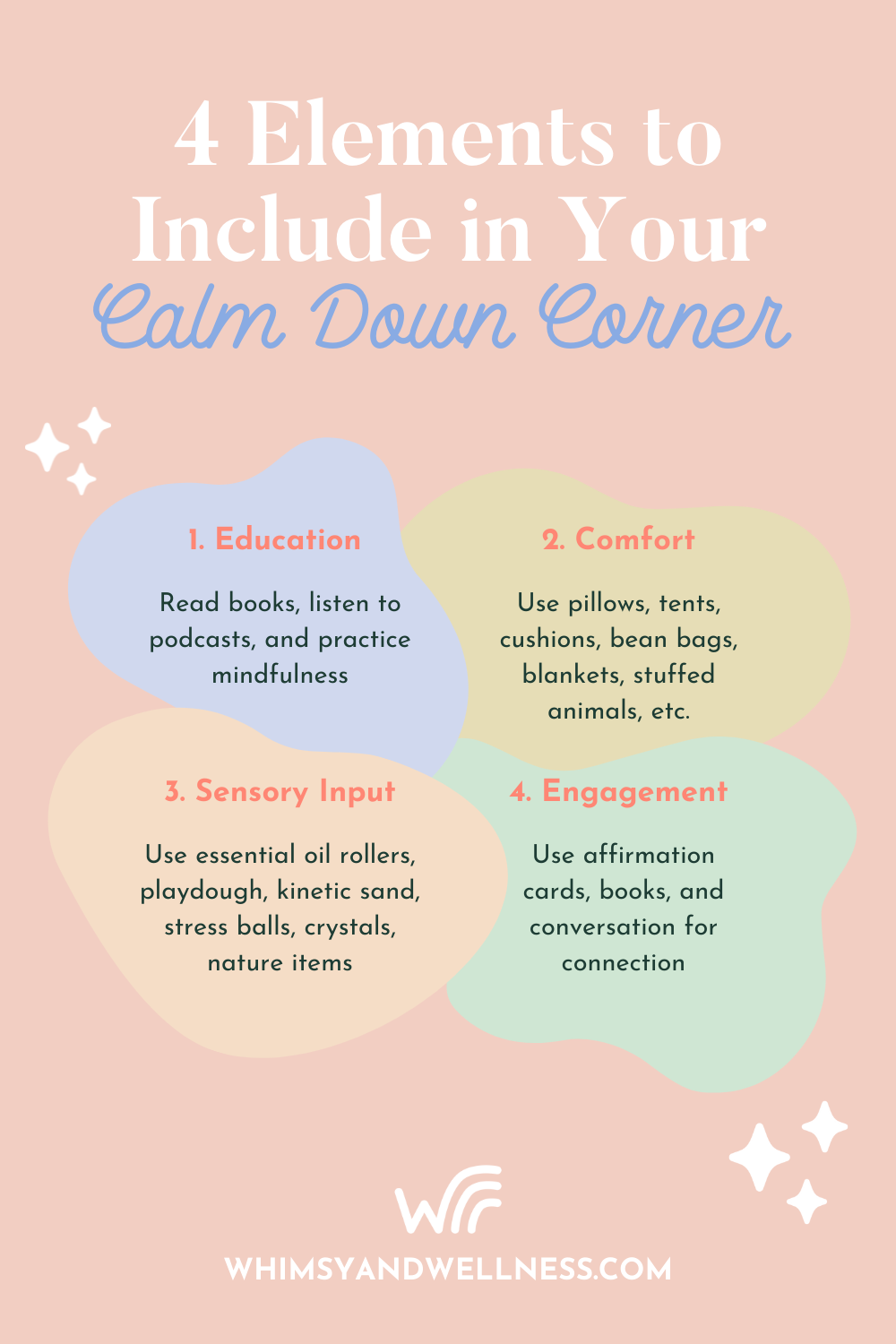
Including these four elements in your calm down corner or peace corner can help children reap all the benefits listed above!
1. Education
Calm down corners begin before the meltdown; showing your children the corner and explaining how to use it while they feel good and are receptive is important. You can even make your own calm down corner to model it for your kids!
It’s also important to make talking about feelings and emotions part of your classroom or everyday life. You can read books, listen to podcasts, and practice mindfulness.
Most people include educational posters, books, and/or checklists inside their calm down corner. These can be simple or complex depending on your kids/students. We’ve included some of our favorites in our roundup below.
2. Comfort
Comfort is such an important part of the calm down corner! Using pillows, tents, cushions, bean bags, blankets, stuffed animals, etc. can help make children feel warm and loved.
A comfortable corner also makes the space extremely inviting; children will want to be in their comfort corners even when they’re not upset (which is a great thing).
3. Sensory Input
Self-regulation is the ability to monitor and control your own feelings and behavior and sensory input can play an important role in helping children become calm and reflect on their emotions. We’ve included lots of ideas for this in our roundup below, but a few helpful ideas are an essential oils roller bottle or sensory playdough.
4. Engagement
The goal of self-regulation and everything else in the calm down corner is ultimately connection. We want kids to connect with themselves and then with other people. Engagement is the zero-judgment zone around the calm down corner. Children can use affirmation cards, books, or conversations to help them connect back with the world, now that they feel safe to do so.
How to Put Your Calm Down Corner to Use
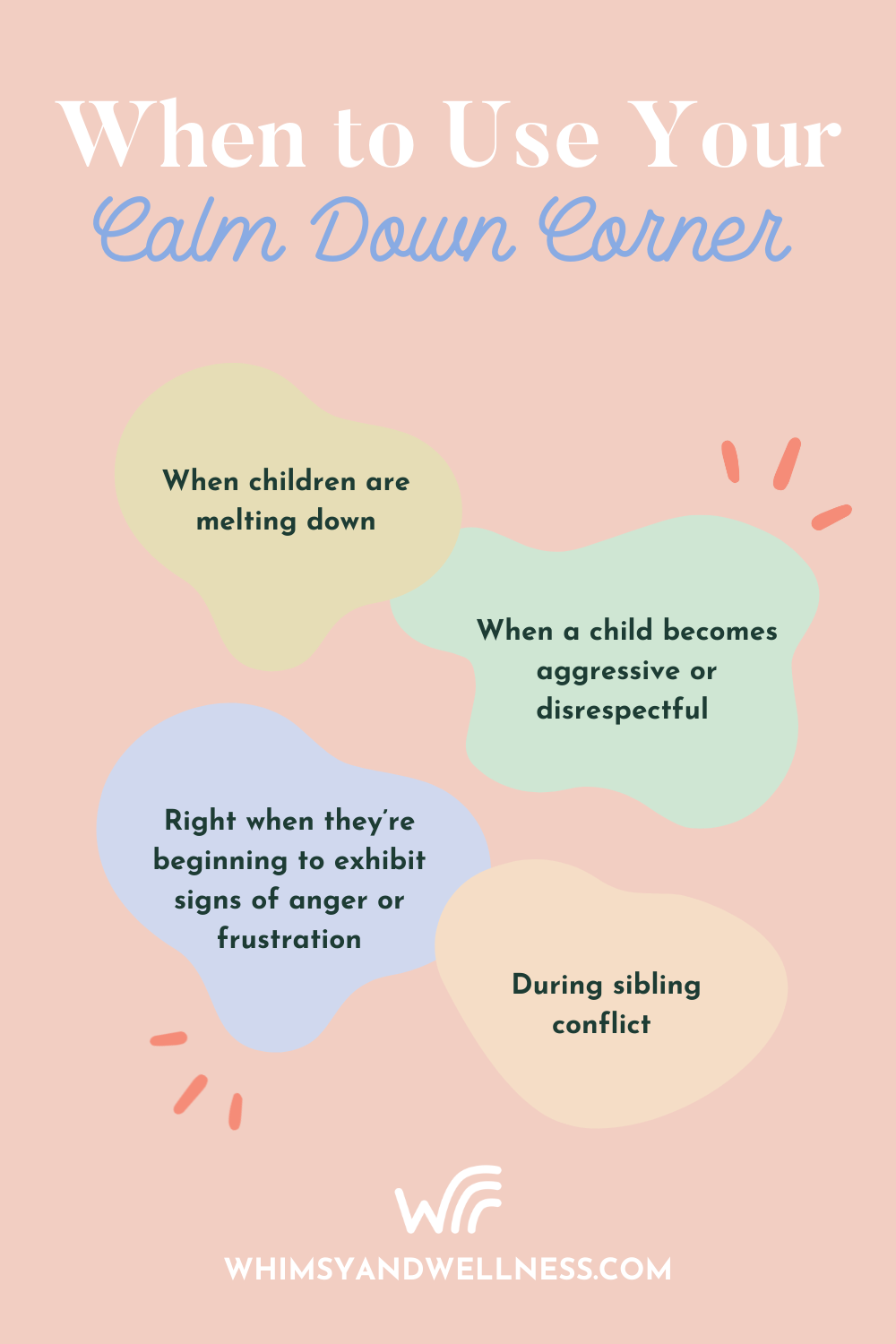
Mindfulness expert Tejal V. Patel says to use calm down corners:
- When children are melting down
- When a child becomes aggressive or disrespectful
- During sibling conflict
- Right when they’re beginning to exhibit signs of anger or frustration (Tejal says you can help children learn to recognize these signs for themselves)
Tejal also points out the difference between time in and time out. Time out is a punishment, but a calm down corner (an example of time in) should never be used as a punishment.
This video is a great example of an elementary school is utilizing calm down corners (they call them peace corners).
Children like Abby, a fourth-grader interviewed in the video, are able to recognize the signs of their frustration and take themselves to the peace corner. As a result, the entire school’s academic performance improved!
How Do You Use a Calm Down Corner With a Toddler and a Preschooler?
Calm down corners work a little differently with toddlers and preschoolers. For them, you’ll do more modeling.
When your little one is throwing a fit or acting out, instead of enacting some kind of punishment or trying to teach them, you’ll move them to the calm down corner and help them find a way to be calm. Then, you can discuss what just happened, and help them think through (and even act out!) better ways to handle frustration or anger.
There are days when you might find yourself leading a toddler or preschooler to the calm down corner a *lot*! Learning to self-regulate is a skill that can take a long time, but it’s definitely a gift you’ll give your child.
It’s also totally ok to go to your own calm down corner first! There’s no shame in needing to take a minute to calm down and regroup. In fact, you’re directly modeling for your child how to handle overwhelming emotions.
Here’s What to Include in Your Calm Down Corner

Everything in your calm down corner should provide: education, comfort, sensory input, and/or help the child re-engage with the world.
Here’s what your calm down corner can include:
1. Comfortable Chair/Pillows/Rug
Whatever says “comfort” to your kids or students. Pillows, blankets, stuffed animals, bean bag chairs, comfy rugs… or even weighted blankets or this weighted calm down sensory pillow.
2. Posters
You can use posters to educate, delineate the space, and/or create a beautiful area!
These calm down posters are all calming and beautiful, and can help preschoolers and elementary students learn to begin to self-regulate by identifying their feelings and choosing healthy next steps:
- Printable Calm Down Corner Kit from Etsy (includes 3 posters, printable cue cards and breathing technique cards, feelings check-in sheet, traceable calm down pattern sheets, and hug vouchers)
- Printable Calming Tools Poster for Kids (and one for Adults!) from Etsy
- Positive Zen Wall digital download from Etsy
- Montessori Calming Techniques Printable Poster from Etsy
- How Are You Feeling? Rainbow Wall Chart from Etsy
- My Feelings Montessori Poster from Etsy
- Zones of Regulation printable poster from Etsy
You could also use beautiful scenes from nature for your calm down corner (science tells us even just looking at photos of nature can help relieve anxiety):
- Foggy seaside poster from Target
- Wildflowers on a hill from Target
- Waves rolling in from Target
- Unsplash photos are totally free to download and print; you can try this gorgeous sunlit tree or these trees from below or these lovely coneflowers
3. Photos of Loved Ones
You can hang photos of loved ones on the wall, or slide some into a photo book!
4. Calm Down or Sensory Bottles
Making your own sensory or glitter bottles is SUPER easy, but you can also buy handmade calm down bottles!
5. Checklists, Cue Cards, Flash Cards, Tracing Sheets, etc.
If your students or kids are old enough, checklists or worksheets can help them work through their feelings, empowering them to make their own healthy choices.
If they’re too young for worksheets, they can also benefit from cue cards. Here are some favorites:
- Calm Cards to help empower kids to choose their own calm activity (digital download from Etsy)
- Affirmation Cards for Kids
- Calm Down Corner Kit on Etsy
- Calm Down Cards Printables
- Printable Self-Esteem and Confidence Worksheets
- 3 Minute Gratitude Journal for Kids (5-9+ years)
- Mindful Kids: 50 Mindfulness Activities boxed card deck (3-8 years)
6. Essential Oils
We’re huge fans of using essential oils for mindfulness. It’s like an instant stress reliever for all of us, and having a feelings roller bottle can really help kids find a constructive outlet to do something about their feelings.
You can find kid-friendly roller bottles here, and here’s how to make your own roller bottle with essential oils.
Calm Down Corner Roller Bottle Recipe
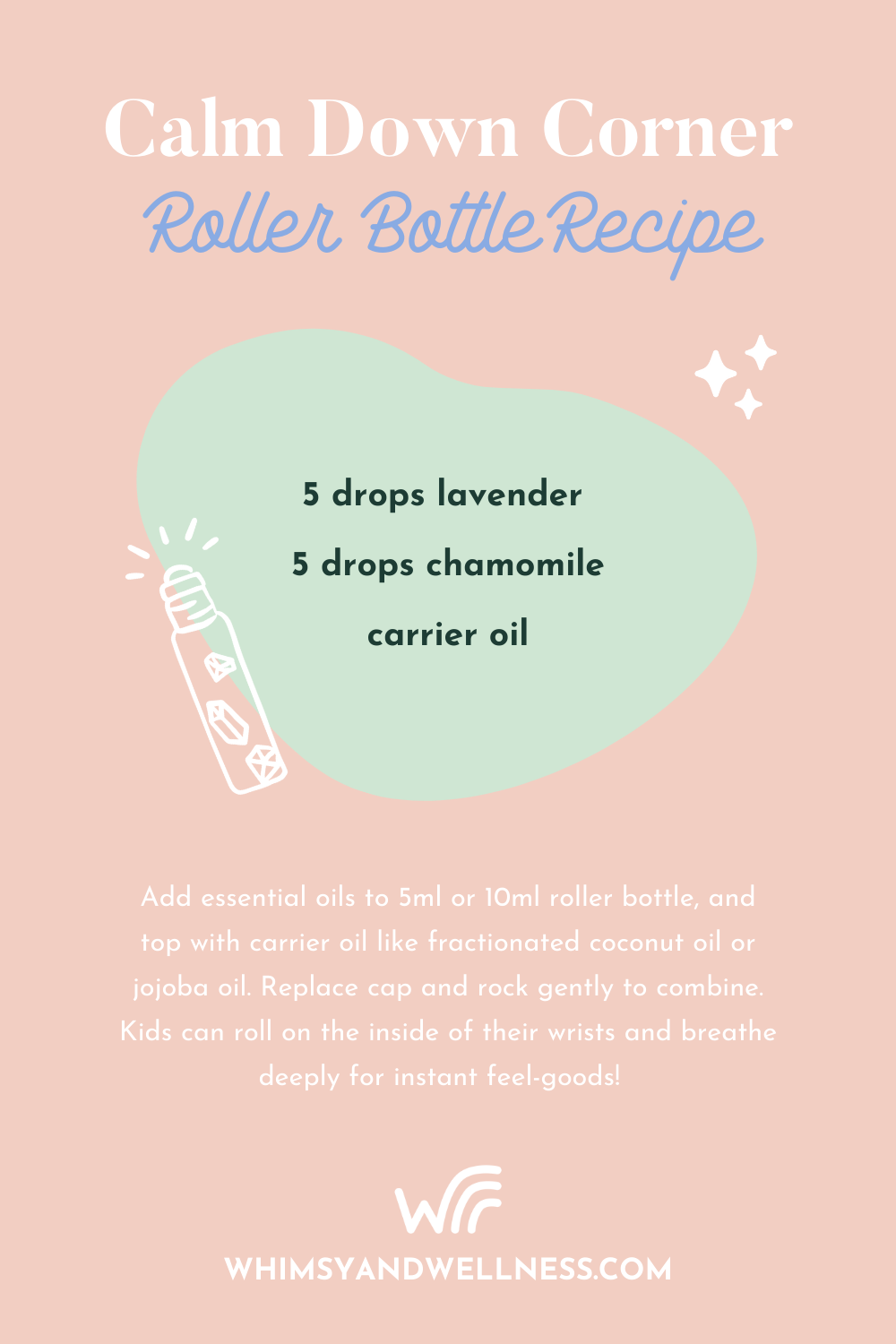
5 drops lavender
5 drops chamomile
Add essential oils to 5ml or 10ml roller bottle, and top with carrier oil like fractionated coconut oil or jojoba oil. Replace cap and rock gently to combine. Kids can roll on the inside of their wrists and breathe deeply for instant feel-goods!
P.S. you can also diffuse essential oils for help with stress and anxiety! Here are our favorite oils for anxiety and stress, plus recipes!
7. Art Therapy Supplies
Art is deeply calming and soothing. You can check out our post here about great art therapy activities for adults, highschoolers/teenagers, and older elementary ages.
For younger children, you can add:
- Finger painting materials
- Watercolors
- Crayons, markers, colored pencils
- High-quality paper or fun coloring sheets
8. Yoga
Yoga is a beautiful way to help children and adults center back into their bodies and effectively release overwhelming emotions.
Try these downloadable Yoga Pose Cards from Etsy or grab these super popular cards from Amazon.
9. Tracing Cards
Tracing cards are so simple, but surprisingly soothing. You can print these finger tracing calming cards from Etsy or download our tracing/breathing cards (for free) right here.
10. Books
Books can be the activities children “do” during calm down corner, but they can also be part of how you help a child re-engage with their community after completing calming down.
It’s also great to read and talk about these books way before you need them. Talking about feelings and normalizing having all kinds of emotions can give kids the language they so desperately need to navigate their worlds!
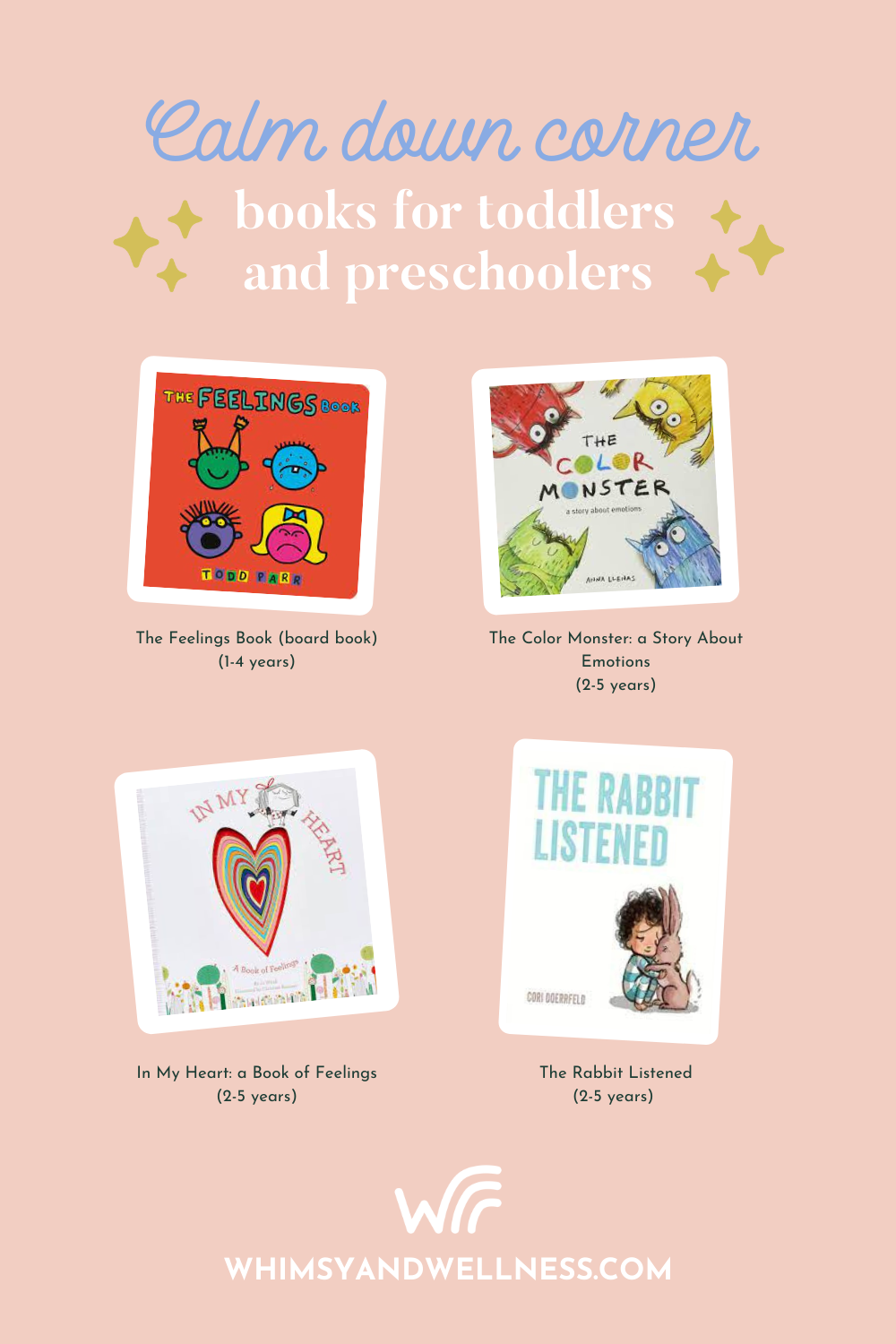
Calm down corner books for toddlers and preschoolers:
- The Feelings Book (board book) (1-4 years)
- The Color Monster: a Story About Emotions (2-5 years)
- The Rabbit Listened (2-5 years)
- In My Heart: a Book of Feelings (2-5 years)
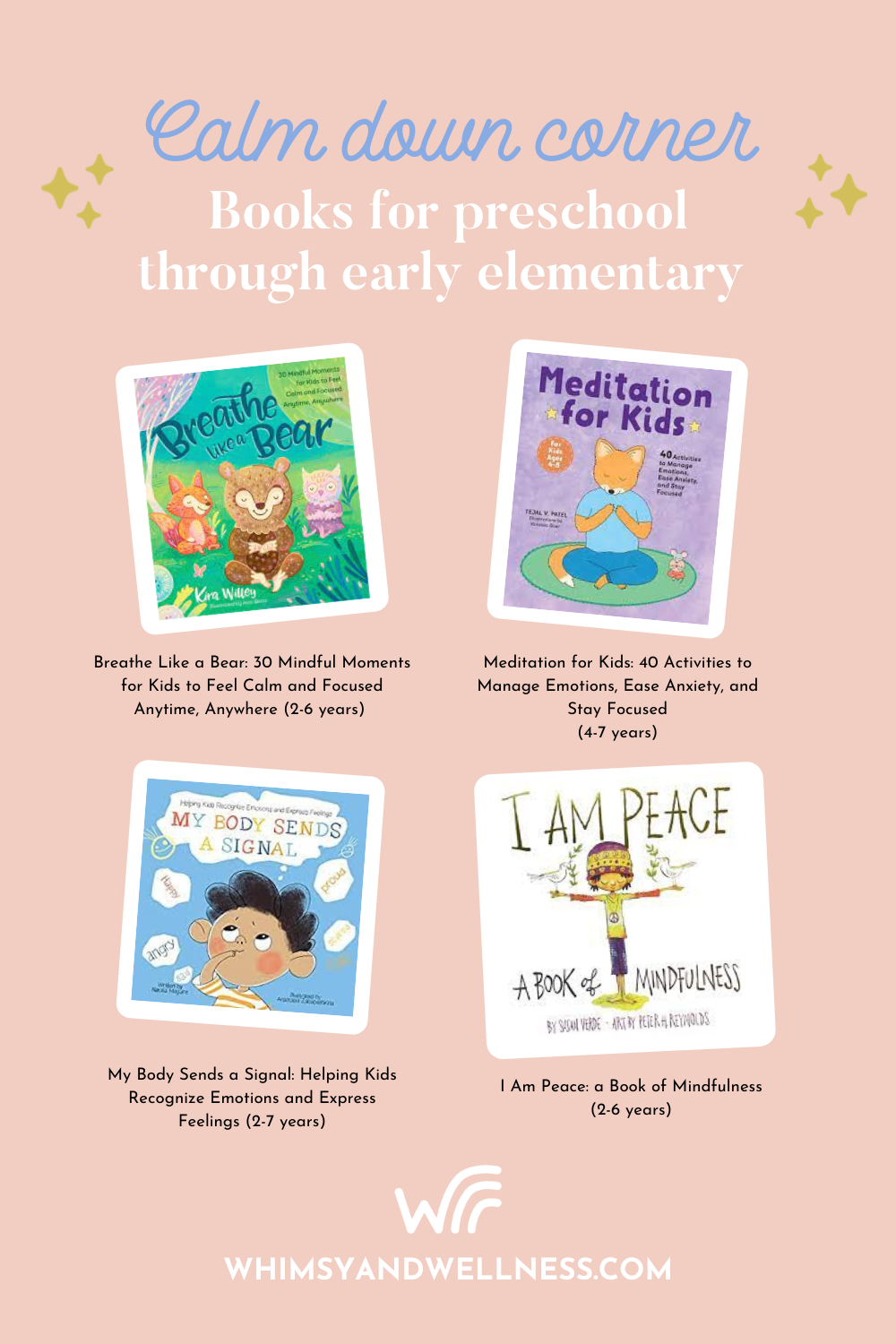
Books for preschool through early elementary:
- Breathe Like a Bear: 30 Mindful Moments for Kids to Feel Calm and Focused Anytime, Anywhere (2-6 years)
- I Am Peace: a Book of Mindfulness (2-6 years)
- My Body Sends a Signal: Helping Kids Recognize Emotions and Express Feelings (2-7 years)
- Meditation for Kids: 40 Activities to Manage Emotions, Ease Anxiety, and Stay Focused (4-7 years)
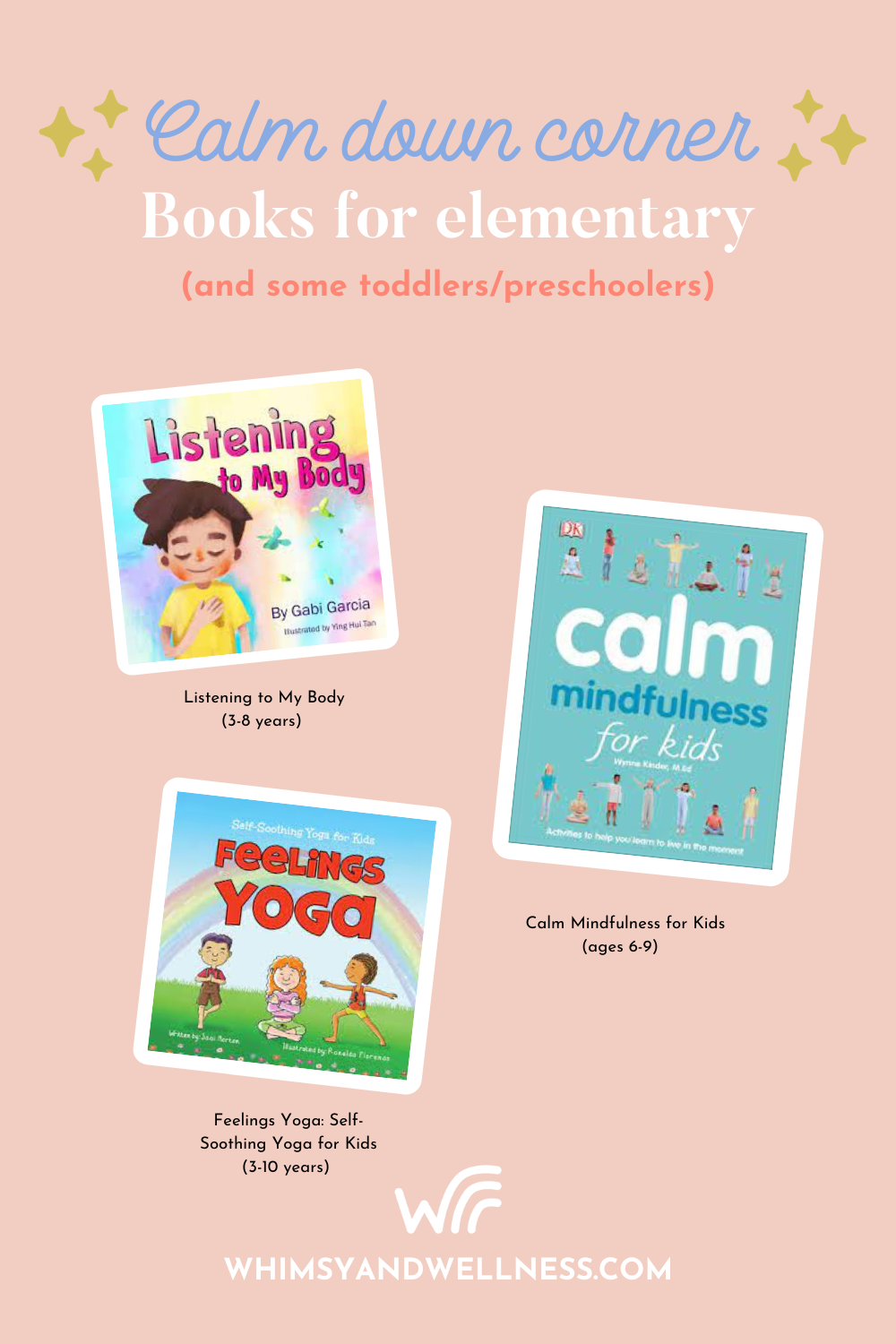
Books for elementary (and some toddlers/preschoolers):
- Listening to My Body (3-8 years)
- Calm Mindfulness for Kids (ages 6-9)
- Feelings Yoga: Self-Soothing Yoga for Kids (3-10 years)
11. Sensory Rice
You can also store sensory rice in a plastic bin or container in your calm down corner. Sensory rice is soothing to play with, and when made with essential oils and crystals, can have added calming components.
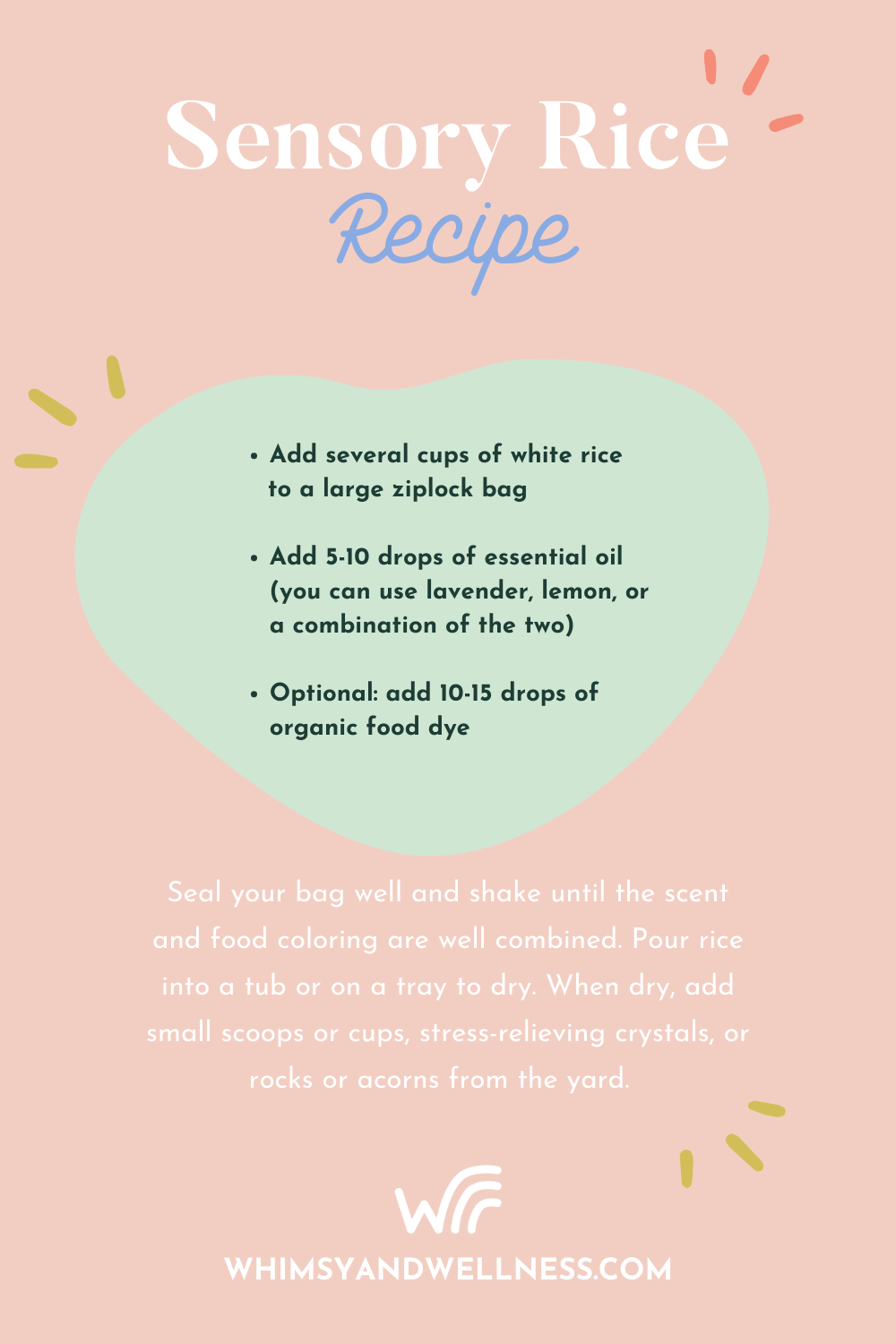
Here’s our recipe for sensory rice:
- Add several cups of white rice to a large ziplock bag
- Add 5-10 drops of essential oil (you can use lavender, lemon, or a combination of the two)
- (Optional: add 10-15 drops of organic food dye)
- Seal your bag well and shake until the scent and food coloring and well combined
- Pour rice into a tub or on a tray to dry. When dry, add small scoops or cups, stress-relieving crystals, or rocks or acorns from the yard.
12. Mindfulness Crystals
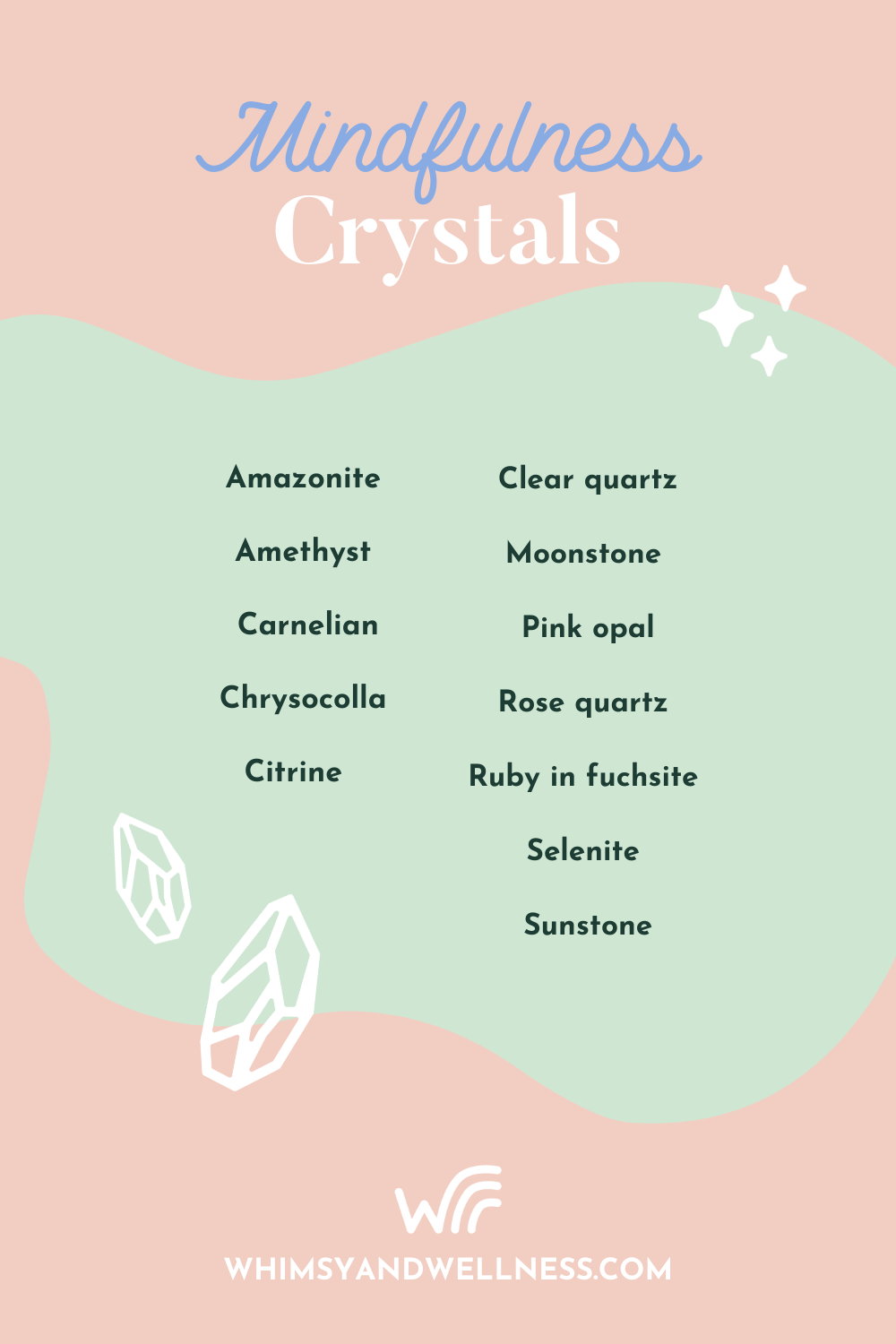
We wrote a whole post here about using essential oils and crystals to help teach kids mindfulness.
But in a nutshell, crystals are little nuggets of earthy goodness that help destress, calm, and soothe upset feelings! You can include crystals to hold in your calm down corner, or you can include gemstone roller bottles or pocket crystals.
Children can use crystals while they meditate, or they can use them as natural “fidget spinners,” or they can hold their crystals while they “transfer” their negative energies away from them into the stones. They can also imagine their gemstone comforting them or giving them strength, or reminding them of an affirmation or intention.
Some of our favorite crystals to use as worry stones are:
- Amazonite
- Amethyst
- Carnelian
- Chrysocolla
- Citrine
- Clear quartz
- Moonstone
- Pink opal
- Rose quartz
- Ruby in fuchsite
- Selenite
- Sunstone
13. Sensory Playdough or Kinetic Sand
Sensory playdough or kinetic sands are like sensory rice–great physical ways for children to calm and self-regulate. Here’s how to make sensory playdough with essential oils.
14. Plants
Plants are instantly healing and soothing! Try adding an indoor plant or two to your child’s calm down corner.
15. Timer
Kids can stay in the calm down corner till they feel better, but if they’re older (or in a classroom setting), timers are super helpful. They can set their own timer for five minutes, and repeat it as often as they need to.
16. Stress Balls
Like playdough or sensory rice, but less messy! Stress balls are great to hold and squeeze. You could also try Dimpl toys (trust us, they’re not just for babies!) or bubble wrap or any other kind of rhythmic toy.
17. Nature Supplies
Yep, nature is the ultimate soother. You can collect small nature things like acorns, pinecones, leaves, and rocks and place them in baskets. Children can hold, sort, and arrange supplies.
18. Noise-Canceling Headphones
These can be especially great if you’re in a classroom or have kids with sensory challenges!
19. Buddha Boards
Budhha boards can help children practice transience and change. You can purchase or try making your own!
